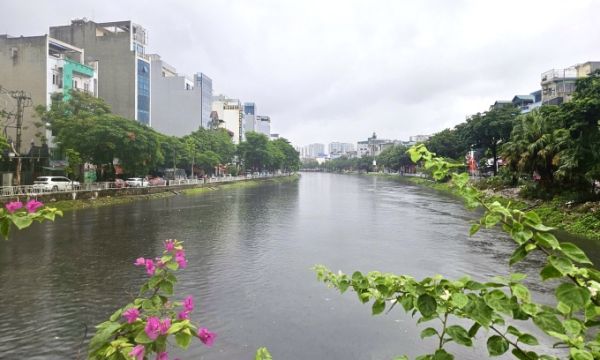
“It was a dreamy scene beyond belief,” Thu Ha, 25, of Tay Ho Ward said. On her way to work on Tuesday morning she was surprised to see the river. The water was almost up to the embankment and clear blue.
The usual floating trash was gone, and fresh green weeds had been washed ashore. Ha stopped to take photos to share the unusual sight with her friends.
|
A section of the To Lich River in Kim Giang-Khuong Dinh, Hanoi, turned clear and blue after heavy rains, Aug. 25-26, 2025. Photo by Dung Sky/Facebook |
Kim Giang Street resident Duc Dung went out in the rain to capture the scene. He said the water level of just one meter below the riverside railing was close to that of the historic 2008 flooding.
The strong current carried the usual black water and trash toward Yen Xa village further downstream.
Dung said the river has turned clear on a number of occasions after heavy rains since early 2024 but never as noticeably as this.
He credited the change to both the rainfall, which diluted and washed away pollution, and authorities’ efforts to dredge parts of it, seal major sewage outlets and begin operation of the Yen Xa wastewater treatment plant. “When the water recedes in a few days, the black color may return.”
|
The To Lich River turns clear and trash-free on the morning of Aug. 26, 2025. Photo by Dung Sky/Facebook |
The Hanoi Drainage Company said the river often turns clear during the rainy season from May to October in northern Vietnam as heavy rain washes away flotsam and water from West Lake flows into it.
The To Lich River section in Kim Giang-Khuong Dinh on the morning of Aug. 26, 2025. Video by Dung Sky/Facebook
Hanoi is implementing long-term measures to revive To Lich. In early 2025 the city told the Department of Construction to plan regular water transfers to the river from West Lake and the Red River. The main challenge in cleaning the To Lich is wastewater treatment.
The new Yen Xa wastewater treatment plant, with a capacity of 100,000 cubic meters per day, began trial operations in December 2024. The treated water is discharged into the Nhue River, leaving the To Lich without much water.
The Hanoi Drainage Company has also sped up dredging of the To Lich riverbed, removing some 60,000 cubic meters of sludge in August alone.
To Lich River used to be a branch of Red River, but was delinked by the French in 1889 as part of an urbanization plan. The river runs 14 kilometers (8.7 miles) through the downtown areas of Thanh Xuan, Hoang Mai and Thanh Tri and has become infamous for its stench and black water.
Over 200 sewage outlets empty 150,000 cubic meters of untreated household wastewater every day into it, according to the city Department of Natural Resources and Environment in 2020. Wastewater from factories adds to the pollution.
 |
|
The To Lich River is usually black and foul-smelling. Photo by Viet An |
Thuy Phuong, 21, who has been renting a room on Nguyen Khang Street for the last six months, said this is the first time she has seen the river in such a state.
She usually wears two layers of masks whenever she goes past it to avoid the odor. Her house is next to the river, but she never opens the windows for fear of the stench.
But on Tuesday morning she opened all her windows. From her second-floor balcony, she saw the river flowing clear and blue, unlike its usual dark color.
She planned to take a walk along the riverbank after the rain, something she had never done before. “I hope the river will be restored so the clear water lasts,” she added.